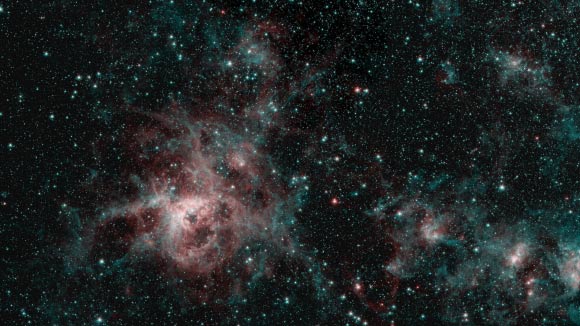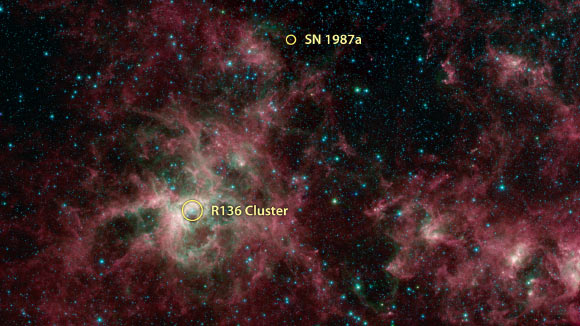Using data from NASA’s Spitzer Space Telescope, which is set to be retired on January 30, 2020, astronomers have generated a new view of the Tarantula Nebula, which is located in the southern constellation Dorado, about 170,000 light-years away in one of our closest galactic neighbors, the Large Magellanic Cloud.

This image of the Tarantula Nebula combines data from multiple Spitzer observations, most recently in February and September 2019. The image shows the nebula in two wavelengths of infrared light, each represented by a different color. The red color at the heart of the nebula shows the presence of particularly hot gas emitting infrared light at a wavelength of 4.5 micrometers. The blue regions are dust composed of molecules called polycyclic aromatic hydrocarbons. Regions emitting both wavelengths appear white. Image credit: NASA / JPL-Caltech.
“I think we chose the Tarantula Nebula as one of our first targets because we knew it would demonstrate the breadth of Spitzer’s capabilities,” said Spitzer project scientist Dr. Michael Werner, astronomer at NASA’s Jet Propulsion Laboratory.
“That region has a lot of interesting dust structures and a lot of star formation happening, and those are both areas where infrared observatories can see a lot of things that you can’t see in other wavelengths.”
Infrared light is invisible to the human eye, but some wavelengths of infrared can pass through clouds of gas and dust where visible light cannot.
So astronomers use infrared observations to view newborn stars and still-forming protostars, swaddled in the clouds of gas and dust from which they formed.
Also known as 30 Doradus and NGC 2070, the Tarantula Nebula is a hotbed of star formation.
It hosts a starburst region called R136, where massive stars form in extremely close proximity and at a rate far higher than in the rest of the Large Magellanic Cloud.
Within R136, in an area less than one light-year across, there are more than 40 massive stars, each containing at least 50 times the mass of our Sun. By contrast, there are no stars at all within one light-year of our Sun.
Similar starburst regions have been found in other galaxies, containing dozens of massive stars — a higher number of massive stars than what is typically found in the rest of their host galaxies.

This annotated image from Spitzer shows the Tarantula Nebula in infrared light. The supernova 1987A and the starburst region R136 are noted. Image credit: NASA / JPL-Caltech.
How these starburst regions arise remains a mystery.
On the outskirts of the Tarantula Nebula, you can also find one of astronomy’s most-studied stars that has exploded in a supernova.
Dubbed SN 1987A because it was the first supernova spotted in 1987, the star burned with the power of 100 million Suns for months.
The shockwave from that event continues to move outward into space, encountering material ejected from the star during its dramatic death.
When the shockwave collides with dust, the dust heats up and begins to radiate in infrared light.
In 2006, Spitzer observations saw that light and determined that the dust is largely composed of silicates, a key ingredient in the formation of rocky planets in our Solar System.
In 2019, scientists used Spitzer to study SN 1987A to monitor the changing brightness of the expanding shockwave and debris to learn more about how these explosions change their surrounding environment.
_____
This article is based on text provided by the National Aeronautics and Space Administration.







